The selection of a technology proper for our project is sometimes one of the most difficult decisions we make. A wide scope of completely different 3D printing methods forces a question: what are the greatest differences between the specific 3D printers and which speciality materials available on the market will be the best. The last but not least question is obviously the one about the price of 3D printing in the technology we have selected.
3D printing in FDM/FFF technology is one of the oldest and most widespread additive methods in the world. It consists in depositing the subsequent layers of fused material and letting the adjacent layers cool and merge with each other before another layer is deposited.
The FDM technology may be described as a process reverse to CNC numerical cutting. 3D models are transformed in g-codes being sets of instructions. They serve the positioning of drivers, and thus making precise extrusions for the purpose of creating another layer. The technology mostly uses an exact quantity of material required for the specific part, otherwise than in CNC methods which generate high losses of the material we use.
The resolution of high prototyping is affected by many factors, such as accuracy of drivers positioning, calibration by the user, or quality of material applied in FDM 3D printing. Generally, the FDM printing tolerance is 0.15 mm to 0.25 mm.
The greatest FDM advantages include fast adjustment of the filling of the printed 3D models. This means that it is very easy to print a prototype only for checking the adjustment and finishing. With low internal filling, or even hollow core, we save on the cost of material. With the design phase finished we may carry out final control or launch small or medium-sized production series with the final filling of the respective 3D print.
FFF is the most optimal method of fast prototyping of parts which must keep the standard tolerance. The method has been widely used in creating architectural or model mock-ups. The technology guarantees affordable prices and short lead time.
Request for a 3D printed sample
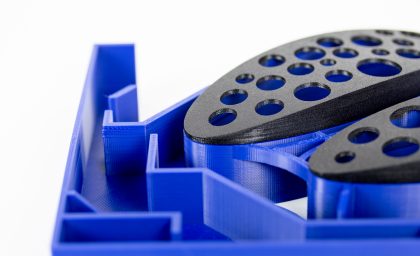
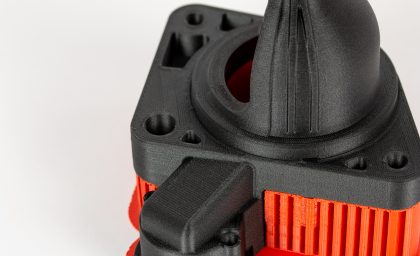
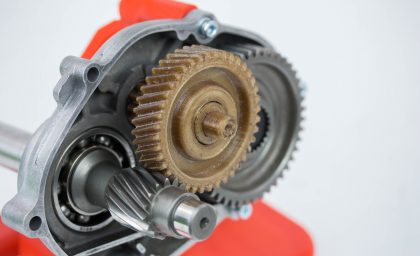
SLS consists in merging polyamide particles with the use of a high-energy laser beam The process starts with chamber filling with powdered material. Along with the progress of printing the working surface lowers and another layer of powder is added. Sintering of the polyamide powder takes place carefully, layer by layer. The 3D SLS technology does not require any supports to be applied, because models are naturally supported by the excess of powdered material which closely surrounds the printout. The solution enables manufacturing of geometrically complex elements with high dimensional accuracy, compared to other 3D printing methods.
SLS is particularly interesting with regard to the use of materials which are broadly applied in the plastics industry, including polyamides. In that technology we may print, for example from a flame resistant PA 2241 FR material assigned the German certificate of CS 25 / JAR25 / FAR 25 § 25-853 (a) App. F Part I, ABD 0031. For elements which need to be more rigid, the PA 3200 GF (glass fibre) is enhanced with powdered glass. The materials most frequently used in industry includes also PA 12 (PA 2200).
SLS devices mostly used in that 3D printing methods have working chambers of the size 340 x 240 x 600 mm, which enables printing quite large elements or hundreds of smaller pieces in a series, ensuring high level of repeatability offered by Selective Laser Sintering. The SLS technology guarantees 0.15 mm tolerance.
Consult your project with 3D printing experts
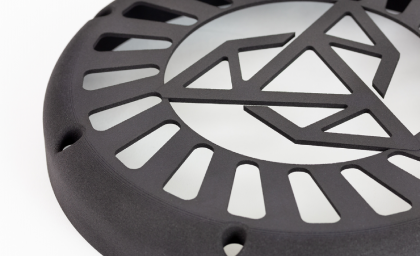

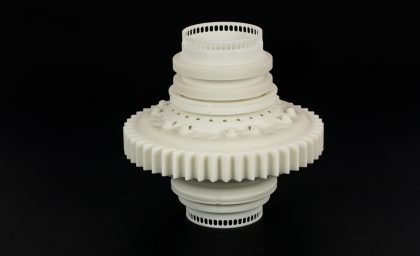
SLA is a 3D printing technology using a liquid photopolymer resin. SLA is a precise 3D printing technology where the model material is cured with an UV laser beam in order to arrive at the final geometry. The material needed for SLA printing – liquid resin – is stored in a tank where the working platform is gradually immersed and then locally illuminated (in the places where the respective model is to be created) by a UV laser. The curing of resin by way of illumination is repeated until the part is ready, and the latter is finally washed with isopropyl alcohol in order to remove the polymer which as not hardened. After cleaning, the printout is placed in a speciality light-setter where the resin models get their final properties.
SLS is particularly interesting with regard to the use of materials which are broadly applied in the plastics industry, including polyamides. In that technology we may print, for example from a flame resistant PA 2241 FR material assigned the German certificate of CS 25 / JAR25 / FAR 25 § 25-853 (a) App. F Part I, ABD 0031. For elements which need to be more rigid, the PA 3200 GF (glass fibre) is enhanced with powdered glass. The materials most frequently used in industry includes also PA 12 (PA 2200).
Stereolithography is one of the most precise 3D printing technologies in the world. It enables recreation on the printed models of even the finest details. The accuracy of the SLA printouts ranges from 0.1 mm to 0.2 mm.
Consult your project with 3D printing experts
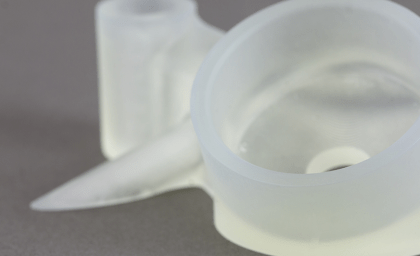
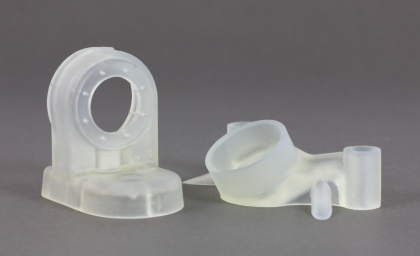
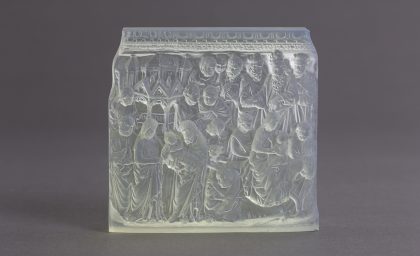
DMLS one of the most advanced technologies. A powerful laser is used in 3D printing to fuse metals and alloys on a micro scale. The main applications of DMLS include the creation of metal parts of complex geometry. Right after the 3D printing process the parts are fully functional (heat-resistant, strong and durable). In fact, the parts are even better than those cast with regard to density, and that translates into their mechanical properties.
Direct Metal Laser Sintering is highly advantageous compared to the traditional production methods, as even the most complex elements may be manufactured into a unit production cycle, which means a reduction of production costs. The DMLS technology combined with topological analysis enables manufacturing of parts which are lighter than those originating from the conventional manufacturing methods.
The metal parts produced in the DMLS technology are exceptionally durable and their weight to durability ratio is very high. Usually, high-resistance materials are used, such as 316 L tool steel, an aluminium alloy, titanium or Inconel (an alloy of nickel and chromium).
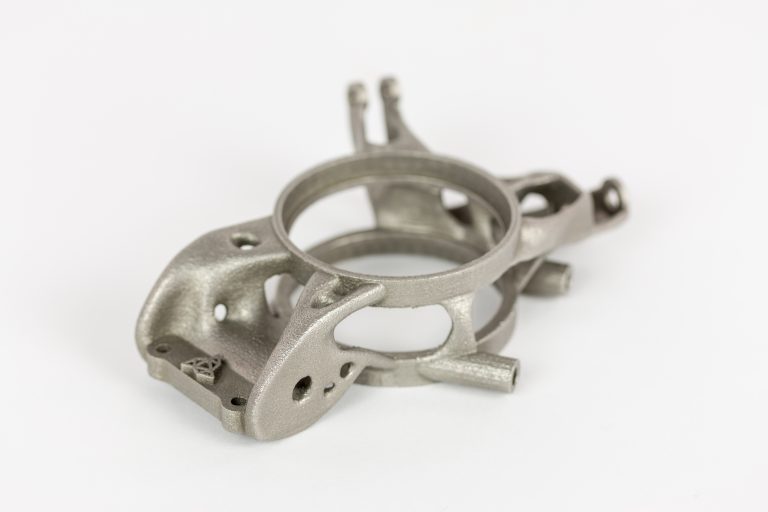
The 3D PolyJet technology is one of the most precise 3D printing technologies in the world. The operation principle is close to the SLA technology, as it is based on curing liquid resin. However, the photopolymer resins are cured with UV lamps in this case. A single layer printed in the technology is only 0.016 mm thin (less than the thickness of a human hair). The accuracy of the technology of less than 0.099 mm may not be matched by any other additive technology.
The PolyJet technology will prove to be adequate in making precise elements where high accuracy is required, due to the application of resins of varied properties, particularly mechanical properties, and the soluble support material. It is dedicated to fast prototyping and creating high-quality, smooth-surface final prototypes.
Check the possibilites of PolyJet in your project
3DGence responds to the needs of the market, providing their line of as many as fifty-two 3D printers based on five different printing technologies (FDM, SLA, PolyJet, SLS, and DMLS).
All the inquiries about 3D services are forwarded to a specialised team of application engineers who help select the proper materials to the respective needs. Write to use and consult your project: [email protected]
Necessary cookies are absolutely essential for the website to function properly. This category only includes cookies that ensures basic functionalities and security features of the website. These cookies do not store any personal information.
Cookies that are used to recognise you and remember your preferences or settings when you return to our site, so that we can provide you with a more personalised experience.
Cookies which measure how often you visit our sites and how you use them. We use this information to get a better sense of how our users engage with our journalism and to improve our sites and apps, so that users have a better experience.
Cookies that are used to collect information about your visit to our site, the content you have viewed, the links you have followed and information about your browser, device and your IP address.